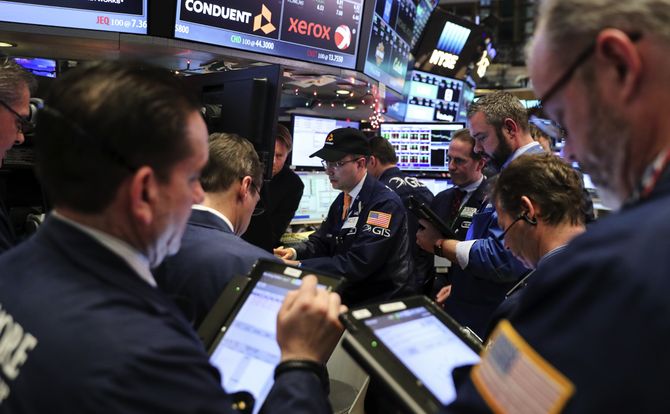Equity markets and the global economy
Company earnings are a powerful driver of financial markets. Recently, however, they have been sending contradictory signals. One reason could be the expansionary credit policies of the past decade, which have distorted balance sheets and weakened competition.

In a nutshell
- Stable consumption and low interest rates give a deceptively strong picture of the economy
- In distorted credit or regulatory environments, company profits may not reflect competitiveness
- This suggests financial markets can say buoyant for a time even as the economy weakens
December 2018 was a disappointing month for stocks. Both the Dow Jones and the Nikkei indexes fell some 9 percentage points, Germany’s Dax dropped more than 6 percent, and other major stock markets (except China’s) followed suit. After years of crying wolf, those who had predicted another global financial crisis were about to be proven right.
Much to their dismay, however, the doomsayers had to take everything back during the first quarter of 2019. While the real economy is not performing very well, financial markets are in rather good shape. Stocks have made a surprisingly strong comeback, and prices of fixed-income securities (government and corporate bonds) remain high. What happened? How should one interpret the robust performance of financial markets amid a decelerating global economy?
This report focuses on three issues that will help shape the economic outlook and future policymaking options. We consider them from an unusual viewpoint: company earnings and the behavior of financial investors.
Steady consumers
The first issue is consumer spending. In recent years, most data have shown that consumer spending is rather stable. This is not a new insight for academic economists. Yet, market operators tend to forget about – or neglect – academic theorizing and look at the hard data. These have confirmed that fluctuations in household income tend to be cushioned by savings, and thus only partially affect consumption. Two important consequences follow.
First, producers of consumer goods (including durables) are unlikely to see a dramatic decline in the demand for their products when the economy slows down. The main challenge they face is not a lack of buyers, but competition from other producers. This may lead to high variance in corporate profits on a company basis, but the industry-wide effects will be much smaller. This explains why stock markets are unlikely to suffer much when the economy slows down.
Perceptions matter and generate market fluctuations. Unless major shocks occur, however, their effects are limited and temporary. For example, during the past few weeks, markets have reacted to the encouraging prospects of the trade talks between China and the United States, while at the same time ignoring predictions of slower growth in the world economy.
Slow growth and relatively high consumption mean declining savings, which will limit future investment.
A second consequence regards savings. Slow growth and relatively high consumption in the Western world (particularly in Europe) mean declining savings, which will limit resources available for investment projects. In this sense, today’s low interest rates are deceptive: they do not stand for abundant savings, only for abundant credit.
Once central bankers embarked on expansionary monetary policies, interest rates have followed the artificial injection of easy credit, rather than the demand and supply of the resources required to develop production capacity. In the long run, the real crunch – a shortage of financing for real investment projects – is bound to surface, and companies whose balance sheets have been propped up by a distorted credit market will run into trouble.
There is little chance of this happening soon, however. Investors are not inclined to pay much attention to what might happen years from now, especially since the global picture might change again in the meantime.
Earnings outlook
A second issue is corporate profits. As commentators later admitted, fears about a disappointing performance in the fourth quarter of 2018 proved wrong. Expectations for future earnings were revised accordingly, and investors flocked back to equities. This explains much of the stock-market rebound in early 2019.
Recently, however, the mood has changed again. Analysts now believe that U.S. companies will match their first-quarter results from last year, then improve their earnings as 2019 goes on. The outlook for the European Union is even more optimistic. Why this should be so is not at all clear.
Does this give reason for concern? Not really. Too much attention is paid in any case to quarterly earnings. The short-term performance of single companies is a poor indicator of profitability in an entire industry or economy. To get a reliable picture of the earnings outlook, one would have to extend the focus from the balance sheets – or prospective balance sheets – of large companies to those of their future competitors. This is clearly an impossible task.

In other words, the key to gauging the health of a single country or the global economy is not the bottom line of incumbent companies, but the ease with which they can be challenged by more efficient producers. This is the essence of a competitive environment. Company profits will necessarily fluctuate as competition unfolds.
Granted, corporate profits are an important signal of success and failure. But they are purely retrospective and matter only when they result from true competitiveness, rather than from artificial advantages gained from regulatory restrictions, trade barriers or distorted credit practices brought about by proactive central bankers.
Debt burden
A third issue regards the size of public indebtedness and the vulnerability of the banking industry in several large advanced countries, such as the U.S., Germany, Italy and France. Despite repeated efforts to rein in expenditure, during the past decade public debt has continued to increase, in real terms and relative to gross domestic product (GDP).
In 2018, sovereign debt in the Organisation for Economic Co-operation and Development (OECD) stood at $45 trillion, up from $25 trillion in 2008. Many major members are past the 60 percent debt-to-GDP ratio, usually regarded as the threshold level for a potentially disastrous financial crisis. Among the countries that have shot past that warning line are the U.S. (106 percent), France (97 percent), the United Kingdom (87 percent) and Italy (130 percent). Germany is still on the safe side, but only marginally so. China is officially at 50 percent, but many observers believe that the true figure is much higher.
Robust consumption patterns and the low cost of debt service will keep dips in stock prices within bounds.
Households and commercial banks are also vulnerable. Although most large lenders are not at risk of bankruptcy, shareholders have failed to notice that the improvement in their balance sheets owes more to new accounting rules than to better fundamentals. In sum, the International Monetary Fund estimated that global indebtedness, including private debt, amounted to 225 percent of the world’s GDP in 2017.
There are two ways to fix these imbalances. One is to balance public budgets and sanction devious accounting practices in the banking industry. The other is to provide easy credit, in hopes that economic growth will obviate the need for painful remedies in the future. World policymakers have gone for the second option, missing no opportunity to announce that they will not change tack. Not surprisingly, potential vulnerabilities have been swept under the rug, while declared corporate earnings have steadily increased.
Safe or not
Under these conditions, we can anticipate three partially overlapping scenarios for the financial markets. According to the first, easy credit will encourage savers to put more and more money into stocks. In the meantime, robust consumption patterns and the low cost of debt servicing will make sure that occasional dips in stock prices will be relatively short-lived and limited in scope.
Under the second scenario, the overall pace of economic growth will continue to slow on declining savings, excessive regulation and a lack of competitive impetus. Financial advisors who focus on picking winners will prove partially right (almost by definition). Some incumbents will keep posting record profits thanks to normative privileges (e.g., subsidies and protectionism), while others will prosper through their efficiency and entrepreneurial insights. Most companies, however, will see their prospects fade even before their earnings drop. This could well be the most likely course of events – but in this case, corporate earnings will provide a very unreliable early-warnings system.
The third possibility is a major shock to the system – for instance, if the Chinese economy crashes or the European Parliament elections raise serious concerns about the survivability of the EU. The latter development could cast doubt on the sustainability of Europe’s public debt and the solidity of its banking system. In this third scenario of a systemic crisis, the only reliable anchor will be economic fundamentals. Almost by definition, a healthy shake-up would eventually occur. Will it happen soon? Probably not.







